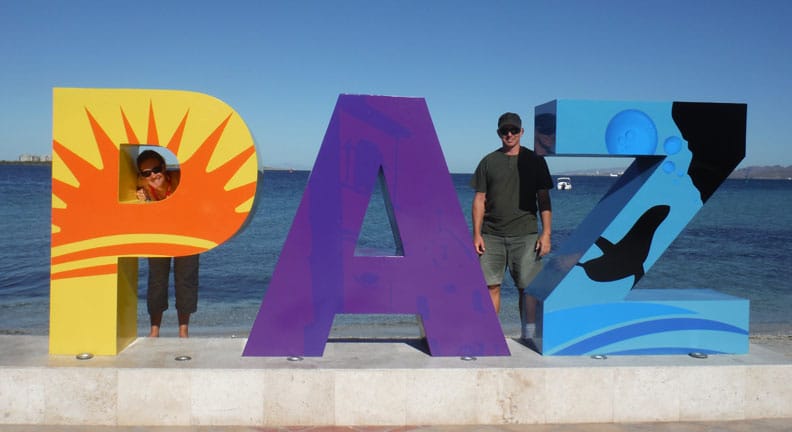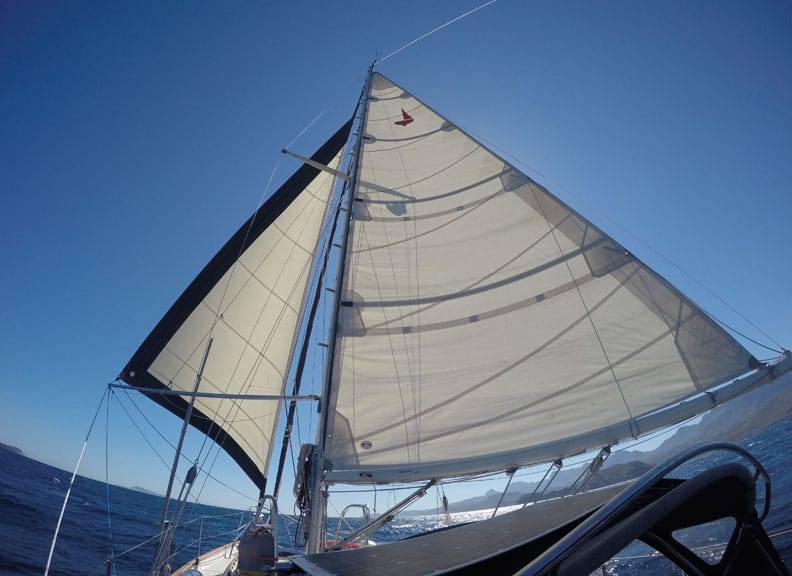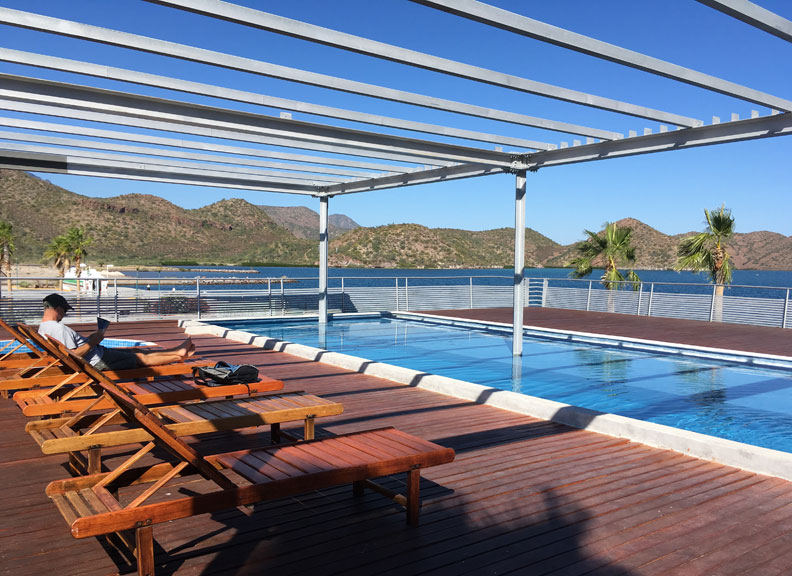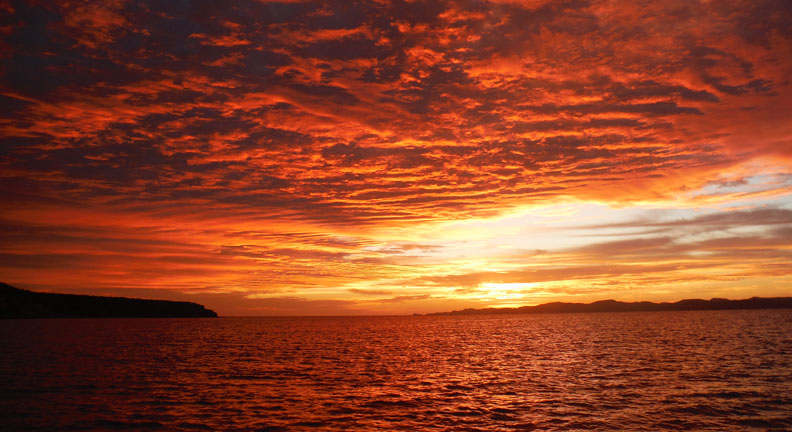Baby Turtles!
Wow! I mean, WOW!!! A gaggle (or more accurately a “bale”) of baby sea turtles had just emerged from their shells below the sandy surface. Amidst the arduous process of climbing out of their nest, we watched in awe as their wrinkly, clumsy bodies (not much bigger than my thumb) flailed up the shallow slope toward the flat sand.
Loggerheads or Olive Ridley?
While I think they were Olive Ridley (most common), I’m not certain. Either way, we saw about 15 of the little dudes crawl out of their hole and head for sea. With increased conservation efforts, the Olive Ridley, a threatened species during the 80’s, has increased to nearly a million females per season…quite an astounding comeback. Many call Baja California home, their offspring returning each year to the exact spot of their birth to nest.
It’s a Hard Knock Life
It’s gotta be rough to be a sea turtle. Before you even get out of the nest you are in danger of being dug up & eaten as an egg by animals or people… or crushed by 4x4 vehicles. Assuming you made it that far and actually hatched, now you’ve got to wiggle up through the suffocating sand - more like a grave than a nest, I’d say. If the sand is too packed down from vehicle traffic it’s difficult, maybe impossible, to get out. Finally, with the help of your siblings, you clawed your way to the surface. Good for you! Now you’ve got to make it out of that caved in caldera to open sand, while repeatedly being trampled on by your fellow escapees. One by one, your grueling march to the sea begins.
Sniper-Crawl to the Sea
Low-crawling like a Marine sniper towards an objective, the babies must immediately traverse the dangerous expanse of beachhead. Scraping themselves along a mere 20ft of beach strand, it probably feels like miles to their tiny bodies… the countless sand depressions akin to scaling hills and valleys. Some turtles were slower than others. After all, they’re just learning to maneuver those flippers. Many required numerous 2-second rest stops to catch their breath and reorient themselves.
A Real Life “Frogger” Game
From the time those turtles step out of their hole everything is trying to kill them – too bad these mini-marines are missing their M-16 rifles. Sea birds like gulls and frigate birds have the marked advantage of speed and height to spot their dark flailing bodies contrasted against the light sand from far away. Land mammals like wild dogs and raccoons are also a danger. One interesting tidbit is that while adult turtles often include crabs in their diet, crabs will also eat baby sea turtles! An example of Mother Nature’s circle of life, I guess. Since land is a pretty perilous place for the youngsters, they are desperate to reach the ocean before becoming Scooby snacks.
Citizen Protection Squad
Most turtles seem to have that homing instinct leading them to the sea, but some need a little push in the right direction. When a few babes headed away from the water, concerned citizen-spectators turned them around… sometimes several times before their innate GPS skills took over. Employees from PROFEPA, which supports the National Sea Turtle Conservation Program, were called in to take notes and monitor activity. They also erected a protective chicken wire barrier around a newly-discovered adjacent nest with a warning sign not to disturb. A bystander informed me that no one had previously discovered this nest; otherwise it would have been similarly marked for protection and monitored until hatching. As it was, the little guys are lucky to have hatched out in the open during the day where concerned Baja Californians could protect them from land predators (and take lots of photos) until they made it to the water.
First Swim
Momma turtle nested in a perfect spot along the calm shores of the Bay of La Paz, so they had no crashing ocean waves with which to contend. I could almost sense their slight hesitation and ultimate relief as they’d hit the water’s edge. The weaker ones seemed so tired, getting rolled in the tiniest of wavelets, dazed and confused for a moment before slowly and awkwardly floating out to sea. The stronger ones would bolt out into the water, duck-diving through the oncoming tiny wavelets and using the receding undertow to their advantage. Furiously they paddled with their tiny flippers on the same instinctive course with a single-minded thought… “Get to the chopper!” Seriously. I swear I heard it.
Ocean Hazards
Once they hit the water though, another epic journey to deeper waters ensues. Migrating hundreds or even thousands of sea miles, babies are constantly in danger of getting chomped on by larger carnivorous fish like grouper, rockfish, barracuda and sharks. A great many die as bycatch, caught helplessly in fishermen’s nets. Incredibly, only 1 in 1000 actually live to adulthood….terrible odds. It’s a hard knock life. I can’t help but wonder what people would do with their lives if we all had such odds.
An App for That
I wouldn’t be surprised if someone has made a kids videogame app by now…like Frogger or Plant Zombies but with turtles: “In their desperate escape to the ocean, adorable sea turtle babies must avoid bird bombs and crab snatchers, sand-castle-moat-digging children and reckless ATV’s, floating fishing nets, sneaky sharks and gulping groupers!” If anyone rolls with this idea, I’d better get a percentage…
Bucket List Item - Check
Only once have we witnessed turtles here in the Sea of Cortez. On our 2-day passage from Mazatlán, we encountered multiple large turtles floating lazily with us back to La Paz. Since then, we’d sadly never seen another…until today. I’d contemplated finding a turtle release program where volunteers can assist hatchlings from known protected turtle sites. But this random event was perfect in its spontaneity…raw nature in action. It’s quite possibly a once-in-a-lifetime experience to witness baby turtles in their first moments. What a great day! Bucket list item complete.
~~~~~~~~~
Be sure to watch my Turtle Trek Video. Baby turtles are adorable! I promise it will make your day.





 RSS Feed
RSS Feed
